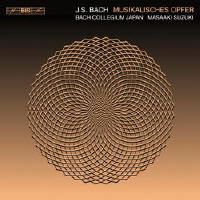Texte paru dans: / Appeared in: |
|
|
Reviewer: Bertil
van Boer
The famous Musical Offering by
Johann Sebastian Bach needs no real explanation, given that performers young
and old have recorded it countless times. Not quite the rite of passage as,
say the Goldberg Variations (the aria of which is also on this disc) or The
Art of Fugue, it nonetheless is well-known as a compendium of Baroque
variations on chamber genres, all based upon the theme allegedly given to
Bach by Frederick the Great. Here, however, we have the work of Masaaki
Suzuki, who leads a selection of the Japanese Bach Collegium, in a series of
pieces that demonstrate his deep knowledge of Bach’s style. These are filled
out by a Trio Sonata (BWV 1038) and a string of extraneous pieces that are
associated with the lengthy Goldberg, perhaps done as a whim by the
composer.
The proof in the pudding, as
it were, is how well the group negotiates the complex counterpoint that Bach
wrote as an answer to the test theme. Harpsichordist Suzuki approaches the
opening crab canon a bit cautiously, but with deliberation, using the two
manuals to an excellent extent. In the Ricercar a 3, the same tempo appears
at the beginning but the touch is lighter as the other voices enter, and the
ornamentation is clear and precise, never intrusive. I found the theme in
all three of the entrances audible but not subordinated to the other voices,
and when the triplet episode enters the playing has a nice depth. Coupling
the manuals together for the Goldberg aria increases the sound tenfold,
though perhaps the loudness was a factor of the microphone placement, but it
seems to jump off the speakers. I like the smoother tempo he takes here, and
in the first canon the bass line is a typical pattern for the Baroque
period, slow and deliberate so that the oddity of this and the following
short bits of canonic imitation can be outlined. Clearly these seem more
like whimsical exercises than real pieces, sort of like Bach playing with
the varieties of counterpoint he knew. Depth is provided beginning in the
trio canon with triplets, in which the strings also participate, though it
probably was intended for harpsichord alone. Each of these short exercises
is less than a minute long (save for the Canon duplex on the fundamental,
which is just barely over the length), and the endings are sometimes a bit
ambiguous. The two trio sonatas show the integration of the Collegium
ensemble. The opening of the Offering cantata has a certain plaintiveness
about it, while the following Allegro is like a steady march, with a smartly
walking theme in which the three lines are distinct. The G-Major Trio Sonata
is more pensive, with a slow and deliberate opening, followed by a faster
movement in which the lines jump about joyously. Apart from the somewhat sparse and muted opening of the Offering, the remainder of the works are full-voiced and clear. I like the interpretations, which are nuanced enough to provide interest but do not neglect Bach’s perpetual contrapuntal motion, which in less expert hands can seem mechanical. The intonation is excellent, and I like the way the Suzuki organizes his various stops on the harpsichord. Although there are many competitors out there, one really ought to give this disc a look for its vibrancy and interpretive skill. | |
|
|
|
|
|
|
|
Cliquez l'un ou l'autre
bouton pour découvrir bien d'autres critiques de CD |
|




